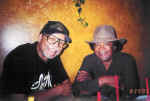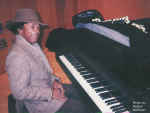 Bebop
or simply "bop" was a post-swing era musical revolution
in several of its aspects: its harmonic elaborations of altered chord
voicings and use of the flatted-fifth chord; its highly syncopated,
polyrhythmic and often extremely rapid tempos; its bold exploration of the
technical limits of each instrument; its movement away from the danceable
rhythms; its use of wordless scat singing and the invention of
"vocalese" by Eddie Jefferson and others. Bebop established a
pinnacle on the African-American cultural music tree. Its predecessors,
swing, traditional, gospel, spirituals and work songs grew from roots in
the blues (directly from Africa) and ragtime (with the post-emancipation
access to European instruments). Rags were mostly written on the black
keys of the piano. The contrapuntal rhythmic patterns that characterized
the ragtime melodies were superimposed upon striding left hand patterns
that were reminiscent of the cake walk and strut dances that were
vestigial remnants of African group dances that survived the plantation
(e.g., the Juba). With bebop the drums fulfilled the orchestral role of
punctuating the intricate melodies and solos and supplying the energy that
fed the performance. The role of timekeeper shifted to the bass, which
also maintained control of the harmonic tone center of the composition.
The piano and guitar supplied the sophisticated shading to the harmonies
as well as rhythmic contrapuntal call-and-response conversation within the
group. The horns were the frontline protagonists, challenging virtuosity
to its limit on every instrument.
Bebop
or simply "bop" was a post-swing era musical revolution
in several of its aspects: its harmonic elaborations of altered chord
voicings and use of the flatted-fifth chord; its highly syncopated,
polyrhythmic and often extremely rapid tempos; its bold exploration of the
technical limits of each instrument; its movement away from the danceable
rhythms; its use of wordless scat singing and the invention of
"vocalese" by Eddie Jefferson and others. Bebop established a
pinnacle on the African-American cultural music tree. Its predecessors,
swing, traditional, gospel, spirituals and work songs grew from roots in
the blues (directly from Africa) and ragtime (with the post-emancipation
access to European instruments). Rags were mostly written on the black
keys of the piano. The contrapuntal rhythmic patterns that characterized
the ragtime melodies were superimposed upon striding left hand patterns
that were reminiscent of the cake walk and strut dances that were
vestigial remnants of African group dances that survived the plantation
(e.g., the Juba). With bebop the drums fulfilled the orchestral role of
punctuating the intricate melodies and solos and supplying the energy that
fed the performance. The role of timekeeper shifted to the bass, which
also maintained control of the harmonic tone center of the composition.
The piano and guitar supplied the sophisticated shading to the harmonies
as well as rhythmic contrapuntal call-and-response conversation within the
group. The horns were the frontline protagonists, challenging virtuosity
to its limit on every instrument.
trombone and trombetto
What is hard bop?
Hard bop is a journalistically created label used to describe the intense, soulful, funkier form of bop that often drew upon gospel flavorings that flourished in the 1950s and 1960s. The composers tended to think of the music as bop but their original compositions were distinguished by original chord sequences. Hard bop is to bebop what contemporary gospel is to hip hop. The most original use of chord progressions occurs in hard bop and contemporary gospel. Standard forms occur in bebop and hip hop that denote the identifying characteristics of the style, i.e. 12-bar blues and 32-bar rhythm changes represent a sizeable percentage of bebop works and a specific drum machine beat, voice timbre and rhyme meter represent a sizeable percentage of hip hop works.
What is vocalese?
What is Spoken Word?
Vocalese is a term used to describe the application of lyrics to previously existing jazz tunes or instrumental solos. The vocalist takes on the role of the horns in their articulation and use of nonsense syllables known as scat singing. The conversion of scat into lyrics and story lines marks the beginning of vocalese which dates back as far as the late 1930s but was perfected by Eddie Jefferson in the early 1940s. Such an application must take account of the articulation of the instrumentalist vs. the vocal technique of traditional singing, hence musicians make the best scatters and vocalese performers in spite of their sometimes diminutive vocal talents.
What is hip hop?
The rap of the mid-to late-1980s was built upon two or three danceable rhythm patterns and funky two-chord bass line motifs that supported story lines in two-line rhyme based on inner city lifestyles and political themes. The hip hop of the early-1990s was characterized by monotonous electronic dance beats, two-line stream of consciousness poetry, the minimal use of harmony or chord progressions or melody, sub-pedal bass tones, scratch jocks, clap tracks, dull, morbid, materialistic, political, violent, or sensual story lines. Toward the end of the millennium the gangsta rap began to fall out of vogue and rappers and DJs adopted more uplifting themes for their poetry. The vocal instrument once again became the frontline protagonist still maintaining the call-and-response Africanism. Vocalists usually talk their part and in the absence of electronic gear also supply vocal rhythms. Occasionally you'll hear a singing voice (usually some variation of the A-minor scale or a motif conforming to the C-major scale (all the white keys). This may be due to the fact that most of the hip hop generation's exposure to music was in a music education class taught by a culturally non-indigenous teacher using a curriculum required by an antiquated European-biased music-education system. The absence of traditional musical instruments was remarkable (perhaps a loud indictment of the music-education programs in the schools). The instruments are typically electronic devices seasoned with sound samples from various sources. The rhythms are also samples that are derived from a drum machine or some other mechanical device. Teenage gangstaz went farther away from music with each new generation of recording artists. Hip hoppers of the religious persuasion on the other hand went deep into creative music rich in African-oriented rhythms and melodies blended with jazz harmonies and chord progressions. Traditional instruments remained available in the church and were learned and utilized in an African-based musical context (sound vs. sheet music). The resultant contemporary gospel music retained the essential elements of the blues and bebop.
What is hip bop?
Hip bop is a new style of music for the new millennium based on bebop and hip hop. Hip bop is characterized by the reintroduction of chord changes and varied poly-rhythms into the music in contrast to the absence of chord changes in hip hop and the standardized rhythm pattern upon which it is built. In hip bop, as opposed to vocalese, the rhythm of the bebop melody is retained or replicated but the melody is replaced by vocal rapping.
What is the history of hip bop and why is it culturally important?
The ever prescient jazz innovator, Miles Davis (e.g., Doo Bop), and to a lesser degree Quincy Jones (e.g., Q's Jook Joint), were among the very earliest to lend credibility to the hip hop culture by combining its elements with some older idioms of African-American music in several recording projects. DJs have in turn sampled the works of their jazz, soul and R & B predecessors as a nod of proper respect extended from their more popular format. At the millennium's end increasing numbers of hip hoppers and poets are rediscovering their roots in the works of The Last Poets, Gil Scott Heron, Oscar Brown, Jr., Jon Hendricks, King Pleasure and Eddie Jefferson. This sets the stage for a mutual cross-fertilization between the few beboppers still alive and active and the hip hoppers now approaching their 30s, well established as a permanent voice of their generation. The soil, once again fertile and thirsty… the farmer once again hopeful… the planting season underway… the harvest will be hip bop.
How does hip bop relate to hip hop?
The bebop of the 1940s and the hip hop of the 1990s are both artistic expressions generated by a warrior class of youthful artists of their respective eras. The language of both art forms consists of idiomatic code spoken by the insiders that broke the rules set by the language of the mainstream culture. The artistic license applied to the art form found its way into everyday language and eventually into the mainstream as hip lingo (1940s) and ebonics (1990s). Both art forms are based in the oral traditions of cultural Africa where the division between music and spoken language does not exist as it does in the European culture. The bebop of the 1940s was characterized by colorful chord changes (often every two beats) and intricate rhythmic melodies and fast tempos that required virtuosic skills of the instrumentalists. The subject matter of both derives from the daily living experiences and realities of the artist. Each put forth a challenge to contemporary conventions.
How are vocalese and hip hop related?
Both are forms of storytelling with music that reflects and speaks to the contemporary folk culture. Both survive as Africanisms in the New World, preserved, recast and expounded by African-American youth performing similar roles to the griots of the African cultures. The OG sets the standard that is emulated (original griot/original gangsta). The DJ presents the music to the public (doctor jazz/disc jockey).
Go to my site www.hipbopper.com and see what I said about bebop in the FAQ section.
Nelson Harrison (trombone, trombetto/composition)







